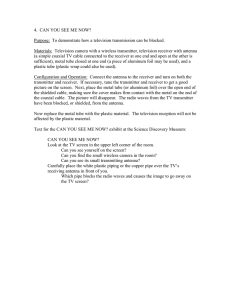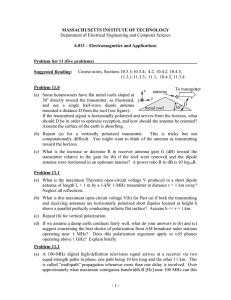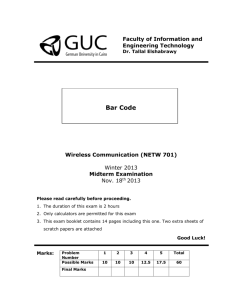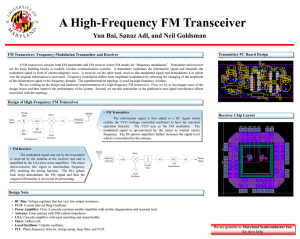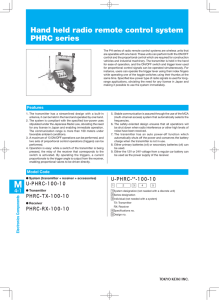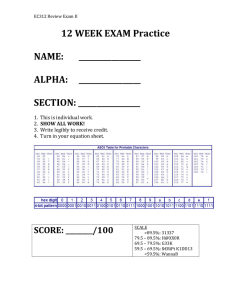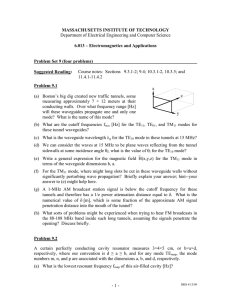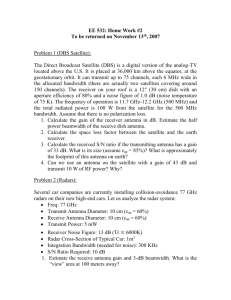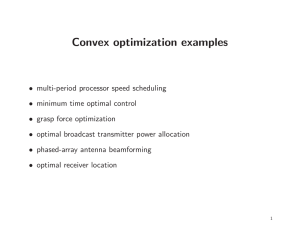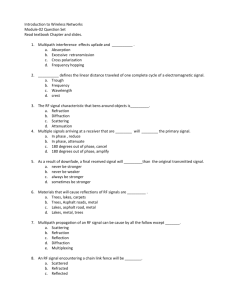Wireless Communication & Networks Sheet - Cairo University
advertisement
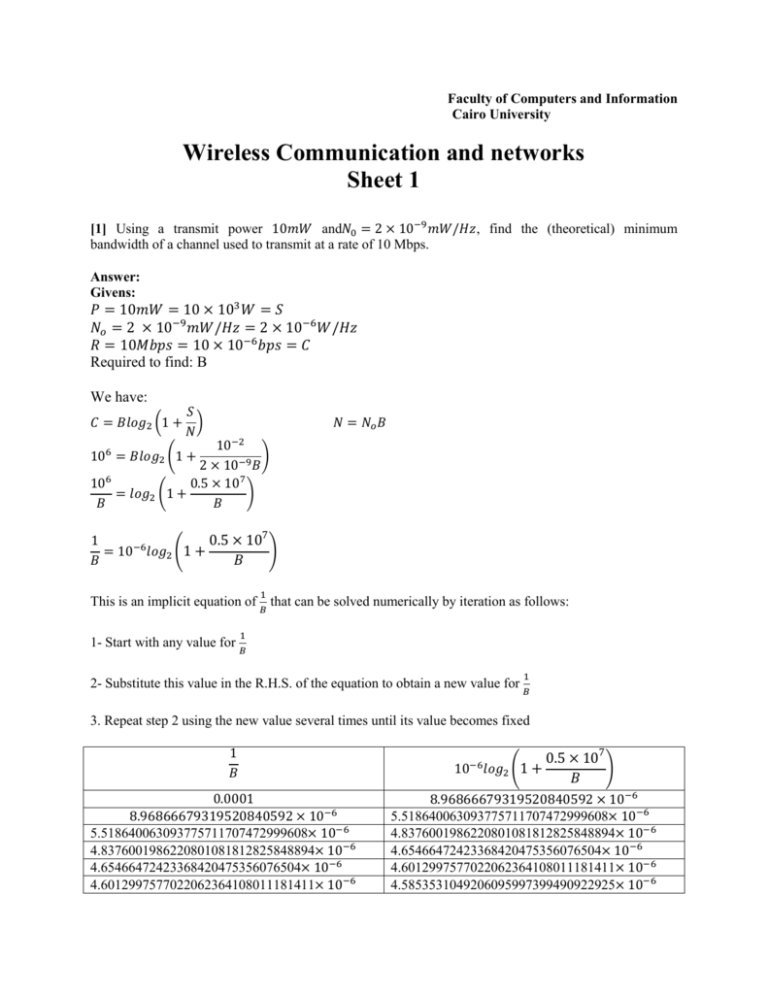
Faculty of Computers and Information Cairo University Wireless Communication and networks Sheet 1 [1] Using a transmit power 10𝑚𝑊 and𝑁0 = 2 × 10−9 𝑚𝑊/𝐻𝑧, find the (theoretical) minimum bandwidth of a channel used to transmit at a rate of 10 Mbps. Answer: Givens: 𝑃 = 10𝑚𝑊 = 10 × 103 𝑊 = 𝑆 𝑁𝑜 = 2 × 10−9 𝑚𝑊/𝐻𝑧 = 2 × 10−6 𝑊/𝐻𝑧 𝑅 = 10𝑀𝑏𝑝𝑠 = 10 × 10−6 𝑏𝑝𝑠 = 𝐶 Required to find: B We have: 𝑆 𝐶 = 𝐵𝑙𝑜𝑔2 (1 + ) 𝑁 𝑁 = 𝑁𝑜 𝐵 −2 10 ) 2 × 10−9 𝐵 106 0.5 × 107 = 𝑙𝑜𝑔2 (1 + ) 𝐵 𝐵 106 = 𝐵𝑙𝑜𝑔2 (1 + 7 1 0.5 × 10 = 10−6 𝑙𝑜𝑔2 (1 + ) 𝐵 𝐵 1 This is an implicit equation of 𝐵 that can be solved numerically by iteration as follows: 1 1- Start with any value for 𝐵 1 2- Substitute this value in the R.H.S. of the equation to obtain a new value for 𝐵 3. Repeat step 2 using the new value several times until its value becomes fixed 1 𝐵 0.0001 8.96866679319520840592 × 10−6 5.518640063093775711707472999608× 10−6 4.8376001986220801081812825848894× 10−6 4.65466472423368420475356076504× 10−6 4.6012997577022062364108011181411× 10−6 0.5 × 107 10 𝑙𝑜𝑔2 (1 + ) 𝐵 −6 8.96866679319520840592 × 10−6 5.518640063093775711707472999608× 10−6 4.8376001986220801081812825848894× 10−6 4.65466472423368420475356076504× 10−6 4.6012997577022062364108011181411× 10−6 4.5853531049206095997399490922925× 10−6 4.5853531049206095997399490922925× 10−6 4.5805534780986836952595053914688× 10−6 4.5791057536545698013970507307224× 10−6 4.5786687872645699572724793866351× 10−6 4.5785368717769994531873142572448× 10−6 4.5805534780986836952595053914688× 10−6 4.5791057536545698013970507307224× 10−6 4.5786687872645699572724793866351× 10−6 4.5785368717769994531873142572448× 10−6 4.5784970455293417069216918423002× 10−6 B =218.412 KHz [2] What is the maximum attenuation in a wireless line of sight communication system given that the transmitter antenna height is 20m and the transmitted power is 5 watts. Answer: 𝑑 = 3.57√4/3 × 20 = 19.365 𝐾𝑚 4𝜋𝑑 2 4𝜋𝑑 2 59217626406.536 𝐿=( ) =( ) = 𝜆 𝜆 𝜆2 So if 𝜆 was given, we would be able to compute L [3] If a channel noise temperature is 450 K and the received power is 3.2 nano-watts, estimate the receiver signal-to-noise ratio for this link, for 10 MHz bandwidth. Answer: 𝑃𝑟 = 3.2 𝑛𝑎𝑛𝑜𝑊 = 3.2 × 10−9 𝑊 = 𝑆 (𝑆𝑖𝑔𝑛𝑎𝑙 𝑃𝑜𝑤𝑒𝑟) 𝑇 = 450 𝐾 𝐵 = 10 𝑀𝐻𝑧 = 10 × 106 𝐻𝑧 𝑘 = 1.3803 × 10−23 𝐽/𝐾 𝑆𝑁𝑅 = 𝑆 𝑁 𝑆𝑁𝑅 = 𝑆 3.2 × 10−9 = = 0.0515 × 106 𝑘𝑇𝐵 (1.3803 × 10−23 )(450)(10 × 106 ) 𝑁 = 𝑘𝑇𝐵 λ2 [4] A hypothetical isotropic radiator has unity gain and effective aperture 4π for radiation of wavelengthλ. Calculate the gain of a satellite dish antenna of effective aperture 3.75 square metres at a frequency of 14 GHz, and estimate the diameter of the parabolic reflector needed to implement such a dish, given an aperture efficiency factor of 0.65. Answer: 𝑓 = 14 𝐺𝐻𝑧 = 14 × 109 𝐻𝑧 𝐴𝑒 = 3.75𝑚2 𝑐 3 × 108 = = 0.0214𝑚 𝑓 14 × 109 To calculate the gain of such antenna 4𝜋𝐴𝑒 4𝜋(3.75) 𝐺= 2 = = 0.1029 × 106 𝜆 (0.0214)2 𝜆= Estimating the diameter of similar parabolic antenna with aperture efficiency =0.65 𝐴𝑒 = 0.65𝐴 = 0.65𝜋𝑟 2 = 3.75 𝑟2 = 3.75 = 1.8357 0.65𝜋 𝑟 = 1.3548 𝑚 𝑑 = 2𝑟 = 2.71𝑚 [5] A deep space communication system uses a Cassegrain antenna of diameter 70m at a frequency of 8.45 GHz. (i) Determine the gain of this dish (in dBi) assuming an aperture efficiency of 80% (ii) Determine the power received by this dish from a transmission of a satellite having antenna gain 2.2 dBi and transmitter power of 10 W at a distance of 180 million kilometers. Assuming a receiver noise temperature of 70 K and a receiver bandwidth of 10 Hz, estimate the maximum receiver signal-to-noise ratio. Answer: 𝑑𝑖𝑎𝑚𝑒𝑡𝑒𝑟 = 70𝑚 𝑟 = 35𝑚 9 𝑓 = 8.45𝐺𝐻𝑧 = 8.45 × 10 𝐻𝑧 𝑐 3 × 108 𝜆= = = 0.0355𝑚 𝑓 8.45 × 109 i) 𝐴𝑒 = 80%𝐴 = 0.8𝐴 = 0.8𝜋𝑟 2 = 0.8𝜋(35)2 = 3080 4𝜋𝐴𝑒 4𝜋(3080) 𝐺= 2 = = 0.0307 × 109 𝜆 (0.0355)2 ii) 𝑇 = 70𝐾 𝑃𝑡 = 10𝑊 𝑑 = 180𝑚𝑖𝑙𝑙𝑖𝑜𝑛𝐾𝑚 = 180 × 109 𝑚 𝐵 = 10𝐻𝑧 𝑃𝑡 (4𝜋𝑑)2 = 𝑃𝑟 𝐺𝑡 𝐺𝑟 𝜆2 2.2 𝐺 = 2.2𝑑𝐵𝑖 ≫ 𝐺 = 10 10 = 1.6596 𝑃𝑡 𝐺𝑡 𝐺𝑟 𝜆2 (10)(1.6596)2 (0.0355)2 ≫ 𝑃𝑟 = = = 6.777 × 10−27 𝑊 (4𝜋𝑑)2 (4𝜋180 × 109 )2 𝑆𝑁𝑅 = 𝑆 𝑁 𝑆𝑁𝑅 = 𝑃𝑟 6.777 × 10−27 = = 7.01 × 10−7 𝑘𝑇𝐵 (1.3803 × 10−23 )(70)(10) 𝑁 = 𝑘𝑇𝐵 [6] Compute the required diameter of a parabolic antenna needed to receive a signal at a power of 2 mW when the transmitted power is 3 watts and the transmission distance is 100 Km in the following cases: (i) The transmitted signal frequency is 320 KHz (ii) The transmitted signal frequency is 5 GHz Answer: i) 𝑓 = 320𝐾𝐻𝑧 = 320 × 103 𝐻𝑧 𝑑 = 100𝐾𝑚 = 100 × 103 𝑚 8 𝑐 3 × 10 𝜆= = = 937.5𝑚 𝑓 320 × 103 𝑃𝑟 = 2𝑚𝑊 = 2 × 10−3 𝑊 𝑃𝑡 = 3𝑊 Assume gain at transmitter = gain at receiver 𝑃𝑡 (4𝜋𝑑)2 𝑃𝑟 (4𝜋𝑑)2 (2 × 10−3 )(4𝜋100 × 103 )2 = ≫ 𝐺 𝐺 = = = 1198.77 ≫ 𝐺 = 34.62 𝑡 𝑟 𝑃𝑟 𝐺𝑡 𝐺𝑟 𝜆2 𝑃𝑡 𝜆2 3(937.5)2 𝐺= 4𝜋𝐴𝑒 4𝜋(𝐴𝑒) = = 34.62 2 𝜆 (937.5)2 (937.5)2 34.62 𝐴𝑒 = = 2.42 × 106 4𝜋 𝐴𝑒 = 0.65𝐴 = 0.65𝜋𝑟 2 = 2.42 × 106 2.42 × 106 𝑟2 = = 1.848 × 106 𝑟 = 1.088 × 103 𝑚 0.65𝜋 𝑑 = 2𝑟 = 544.24𝑚 ii) Same as i) but with 𝑓 = 5𝐺𝐻𝑧 = 5 × 109 𝐻𝑧 [7] If a receiver is moved with a constant speed of 10 km/hour away from a transmitter radiating at a frequency of 8.43 GHz. (i) What is the Doppler shift in the frequency at the receiver side? (ii) Write an expression for the received signal (as a function of time and distance) if the transmitter sends a pure cosine signal. Assume free space noise free channel. Answer: i) ii) ∆𝑓 = − 𝑣𝑡𝑟 𝑓 𝐶 =− 10×1000/(60×60) 3×108 × 8.43 × 109 = −78 𝐻𝑧 Since there will be an attenuation L that is function of distance, the amplitude will 2 change by a factor of √𝐿 , There will be also a time delay of shift of 2𝜋𝑓𝑑 𝑐 = 2𝜋𝑑 𝜆 𝑑 𝑐 (leading to a phase ) and a frequency shift of -78 Hz, The signal will be: 2 𝑑 √ 𝑐𝑜𝑠 (2𝜋(8.43 × 109 − 78) (𝑡 − )) 𝐿 𝑐
